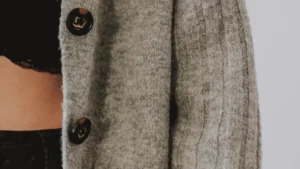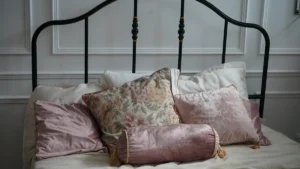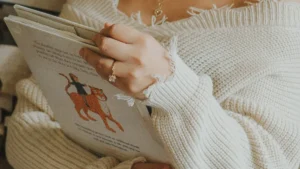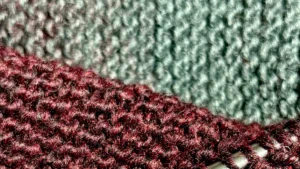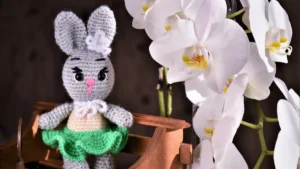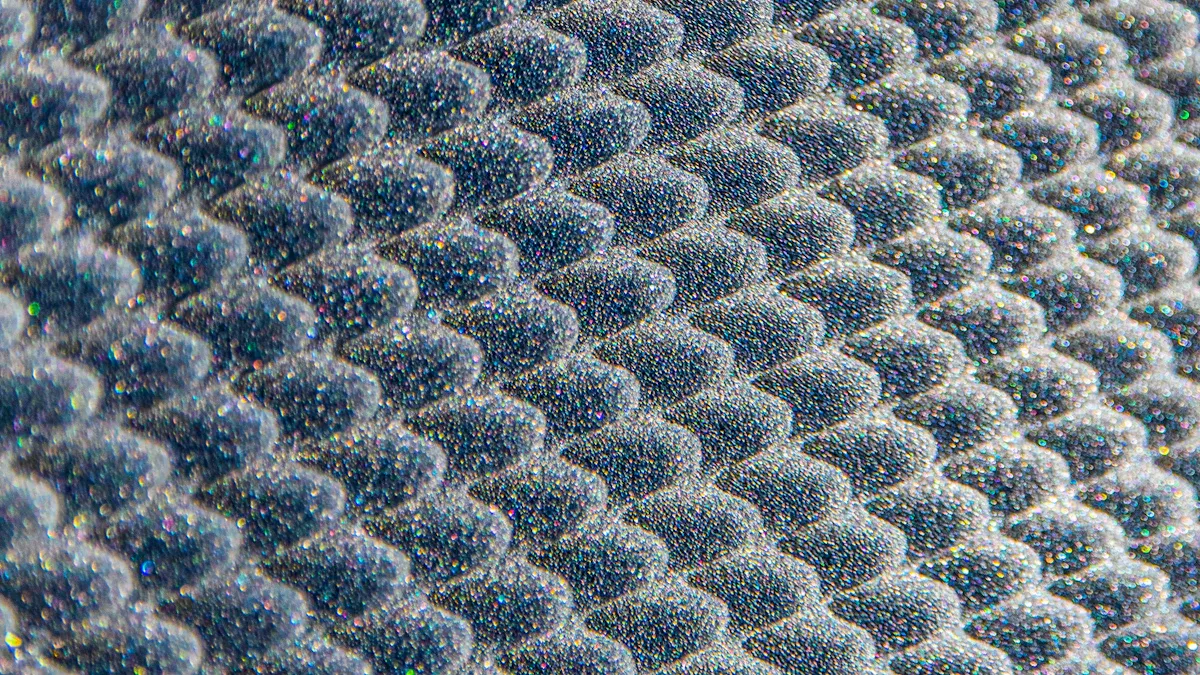
Many people ask if polyester knit fabric or woven fabric is better for their project. The answer depends on what you are making, whether you need stretch, and the desired look. Polyester knit fabric is flexible and comfortable, stretching more than woven fabric. This makes polyester knit fabric ideal for activewear or form-fitting clothes. Additionally, polyester knit fabric is very strong and durable. Polyester is widely used in many new designs, and in 2025, trends will emphasize comfort and functionality in clothing.
Key Takeaways
Polyester knit fabric can stretch a lot and feels soft. This makes it good for sportswear and comfy clothes. Woven fabric keeps its shape and looks tidy. It is great for jackets, dress shirts, and formal wear. Both fabrics are simple to care for but need different ways to sew. This helps stop fraying or stretching. In 2025, more recycled polyester will be used. New technology will help both fabrics become greener and work better. Pick knit fabric for flexible and casual projects. Choose woven fabric for strong and long-lasting things.
Quick Comparison
Polyester Knit vs Woven
Aspect | Polyester Knit Fabric (Knit) | Woven Fabric |
|---|---|---|
Structure | Loops of yarn are linked together to make fabric | Threads cross over and under each other |
Stretch | Stretches easily in many directions | Does not stretch much unless elastic is used |
Durability | Feels soft but can lose shape or get fuzzy | Keeps its shape and lasts longer |
Care | Does not wrinkle much, easy to care for | Wrinkles more and edges can come apart |
Best Uses | Good for sportswear and comfy, tight clothes | Great for blazers, dress shirts, and jeans |
Tip: Knit fabric is comfy and bends easily. Woven fabric keeps its shape and lasts a long time. Pick the one that fits your project best.
Best Uses in 2025
Designers like polyester knit fabric for sports clothes, relaxing outfits, and outdoor wear. Polar fleece and flannel fleece are warm and soft, so people like them.
Woven fabrics are still best for clothes that need to look neat, like blazers, dress shirts, and jeans. Woven fabric is also good for furniture and home items.
In 2025, fake fur made from recycled polyester is popular for coats, jackets, and accessories. This helps people choose animal-friendly and green fashion.
Flannel fleece is a top pick for blankets, pillows, and bed covers at home. These things feel nice and help keep you warm.
Factories now use more recycled and plant-based fibers in both knit and woven fabrics. This change helps people who want eco-friendly and useful fabrics.
Polyester Knit Fabric

Structure & Feel
Polyester knit fabric is special because it is made with loops. This looped design lets the fabric stretch and move easily. Clothes made from it can move with your body. The yarns are linked in loops, so the fabric bounces back after being folded. It does not wrinkle much. Polyester yarns make the fabric strong. It keeps its shape even after many washes. Knit fabric feels softer and smoother than woven fabric. It can feel a little slippery because of the tiny fibers. Polyester knit fabric does not breathe as well as natural fiber knits. But it dries fast and does not shrink easily. There are different types of knit, like jersey, rib, waffle knit fabric, and slub knit fabric. Each type has its own texture and stretch. Waffle knit fabric has a grid pattern that holds warmth. Slub knit fabric uses uneven yarns for a relaxed look.
Pros & Cons
Pros of Knit Fabric | Cons of Knit Fabric |
|---|---|
Less breathable than natural fibers | |
Wrinkle-resistant | Can trap heat and moisture |
Keeps shape well | Prone to static cling |
Quick-drying | May pill over time |
Easy to care for | Can hold odors |
Affordable | Made from non-renewable resources |
Versatile for many uses | May cause irritation for some |
Knit fabric is great for sports clothes, comfy wear, and accessories. It does not wrinkle much, dries quickly, and keeps its color. But it can feel hot and does not let air through like cotton or wool. Some people notice static or small balls on the fabric after wearing it a lot.
Knitted Fabrics in 2025
In 2025, more people will want knitted fabrics because they are comfy and flexible. Brands will use more recycled polyester to help the planet. Factories will make more fabric close to home to avoid extra costs and shipping problems. New machines, like digital printers and 3D knitting, will help make custom designs faster. Waffle knit fabric and slub knit fabric will stay popular because they feel nice and look cool. The need for knit fabric will grow, especially for sports and special clothes. Companies will also make fabric when people order it to cut down on waste and help local workers.
Woven Fabrics
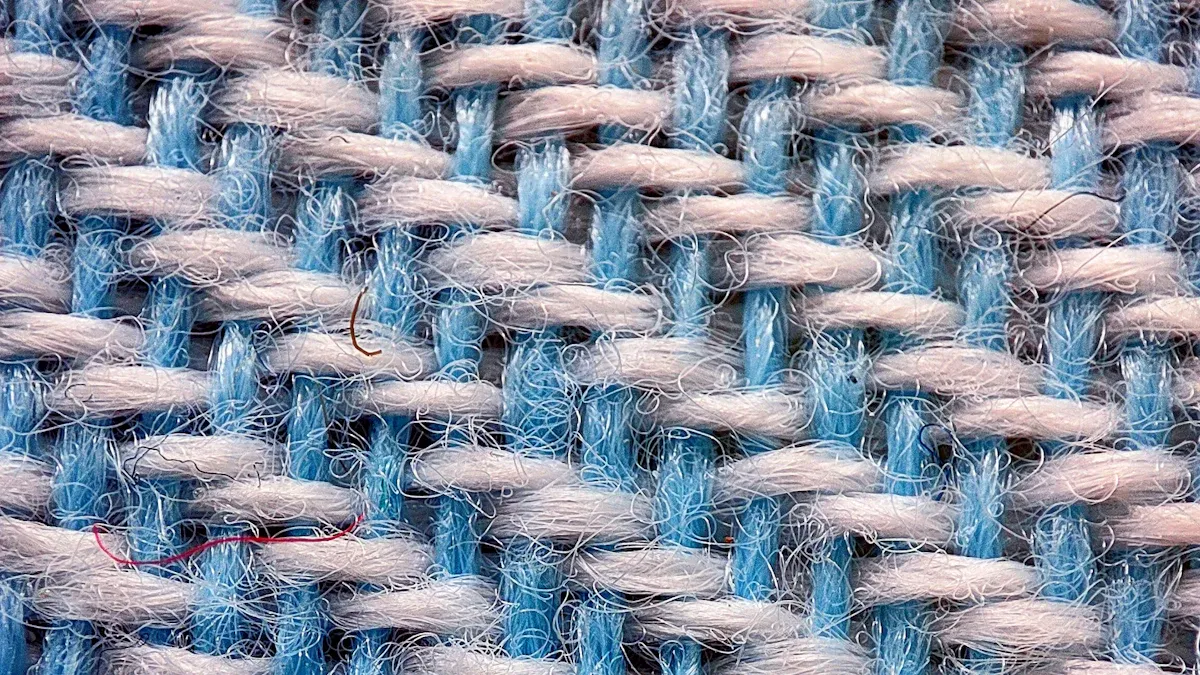
Structure & Feel
Woven fabrics are made in a special way. Two sets of yarns cross each other at right angles. These yarns are called warp and weft. This makes woven fabric strong and stable. Woven fabric does not stretch much, except on the bias. The bias is the diagonal direction. Woven fabrics often feel smooth and crisp. Polyester woven fabric feels more silky and stiff than cotton or linen. Cotton and linen wovens feel cool and natural. Polyester woven fabric can feel warmer and less airy. New technology has made polyester woven fabric softer. But it still feels less natural than plant-based wovens.
Note: Woven fabrics are easier to sew than knits. They do not move or stretch much when you cut or sew them.
Pros & Cons
Woven fabrics have many good points for clothes and home items. They last a long time and do not tear or stretch easily. Woven fabric keeps its shape and does not wrinkle much. It dries fast and does not get damaged by sunlight or chemicals. Many brands mix polyester woven fabric with cotton. This makes it more comfy and lets air through better. But woven fabrics have some downsides. They do not let air through as well as natural fibers. This can make them feel hot or sticky. Woven fabric can hold smells and may bother people with sensitive skin. It can melt if you use high heat, so be careful when ironing. Polyester woven fabrics can hurt the environment. They shed microplastics and do not break down fast.
Pros of Woven Fabrics:
Strong and lasts long
Keeps shape and does not wrinkle much
Dries fast and easy to care for
Good for printing and mixing with other fibers
Cons of Woven Fabrics:
Not very airy
Can hold smells
May bother your skin
Not good for the planet; sheds microplastics
Woven Fabrics in 2025
Woven fabrics will change a lot in 2025. Companies will use recycled ocean plastics to make woven fabric. This helps clean up the earth. New self-cooling woven fabrics will use nanofibers. These open tiny vents when you sweat to keep you cool. Some woven fabrics will have graphene. This makes them stronger and helps control heat. Solar-absorbing woven fabric will let you charge small devices with sunlight. Many brands will use digital printing and dope dyeing. This cuts down on waste and pollution. Woven fabrics will also have antimicrobial fibers. These help stop smells and protect from the sun. All these new ideas will make woven fabric more useful, comfy, and better for the planet.
Difference Between Knit and Woven Fabric
Stretch & Comfort
Knit and woven fabric feel different when you wear them. Knit is made with loops that stretch in many ways. This makes knit soft and lets it move with you. People like knit for T-shirts, leggings, and sports clothes. It does not feel tight and moves with your body. Knit dries fast and keeps its shape after washing.
Woven fabric is made by crossing yarns over and under each other. This makes woven less stretchy than knit. Woven feels firm and holds its shape well. People use woven for pants, jackets, and shirts that need to look neat. Woven is best for clothes that must keep their form.
Woven does not stretch much but gives good support.
Non-woven fabrics do not stretch or move like knit or woven. Non-woven fabrics are made by sticking fibers together, not by looping or weaving.
Tip: Pick knit for sports or clothes that need to move. Choose woven or non-woven if you want things to keep their shape.
Durability & Strength
Knit and woven fabric last different amounts of time. Knit is strong because of its loops, but it can snag or get fuzzy. Woven is even stronger and does not tear easily. Woven stands up to lots of use and washing.
Non-woven fabrics are not as strong as knit or woven. Non-woven can tear more easily and are used for things like masks or wipes.
Fabric Type | Strength Level | Common Uses |
|---|---|---|
Good | T-shirts, leggings, sportswear | |
Woven | Excellent | Jeans, jackets, upholstery |
Non-woven | Fair | Medical masks, wipes, filters |
Appearance & Drape
Knit fabric hangs softly and follows your body shape. It looks smooth and can have different textures, like waffle or rib. Knit usually looks relaxed and casual.
Woven fabric looks crisp and holds pleats and creases. Woven can look formal or neat. People use woven for dress shirts, pants, and blazers.
Non-woven fabrics look flat and do not hang well. Non-woven is often stiff and used for bags or medical things.
Note: Knit and woven fabric make clothes look and feel different. Knit gives a soft, flowing look. Woven gives a sharp, neat look. Non-woven is best for things that do not need to look stylish.
Care & Maintenance
Both knit and woven polyester are easy to care for. They do not shrink or wrinkle much. Do not use bleach or fabric softener to keep them strong. Air drying or laying flat helps them last longer. You can use low heat in the dryer for most polyester.
Knit can come apart at the edges if you cut it, so people finish the edges with glue or stitching. Woven does not come apart as fast but can fray at the edges. Non-woven does not fray or come apart, but it can lose shape if washed too much.
Woven: May fray but keeps its shape.
Non-woven: Easy to care for, but not strong for many washes.
Sustainability Trends
In 2025, how knit and woven are made matters for the planet. Factories use more recycled polyester for both types. New ways help make polyester that breaks down faster and pollutes less. Companies use enzymes to recycle old fabric into new fabric. Some brands add special codes to fabric to help with recycling.
Woven polyester uses more water and energy to make than knit. Dyeing both types uses lots of chemicals and power. Factories try to lower pollution and save water. Many brands use local materials and green energy for both knit and woven.
Non-woven fabrics are changing too. Some now use plant fibers or recycled plastic. These changes help cut waste and make non-woven better for the earth.
🌱 In 2025, people can find knit, woven, and non-woven fabrics that are kinder to the planet. Picking recycled or biodegradable fabrics helps protect the earth.
Aspect | Knit Fabric Manufacturing Process | Woven Fabric Manufacturing Process |
|---|---|---|
Yarn Formation | Loops are made with knitting machines | Threads cross at right angles on looms |
Structure | Loops give stretch and flexibility | Threads cross to make stable, structured fabric |
Common Techniques | Machines make jersey, rib, and double knit | Weaving makes plain, twill, and satin patterns |
Fabric Properties | Stretchy, soft, flexible, fast and cheap to make | Not very stretchy, more durable, keeps shape, takes longer to make |
Applications | Used for comfy clothes, sportswear, socks, and underwear | Used for formal clothes, furniture, and neat outfits |
Choosing the Right Knit Fabric
Project Type
Picking the right knit fabric depends on what you want to make. Each knit type works best for certain clothes or items. Lightweight jersey knit is good for t-shirts and casual tops. Double knit is thicker and works well for jackets or skirts. Fleece knit is warm and soft, so it is great for hoodies or blankets. Some projects need a knit that does not stretch much. Other projects need a very stretchy knit for tight clothes. Think about how you will use the fabric and how it hangs. Rayon knit drapes nicely for flowy dresses, but you must handle it with care.
Tip: Choose the knit fabric that matches your garment’s style and use. Double knit is good for structured things. Jersey knit is better for relaxed clothes.
Desired Qualities
Designers want certain things when picking knit fabric. Stretch and recovery help clothes fit and feel comfy. Durability means the clothes last through many wears and washes. Breathability keeps you cool. Weight and hand feel change how the fabric moves and feels on your skin. Some knits have special finishes, like moisture-wicking or water-repellent, for extra benefits. The fiber content, like polyester or spandex, changes how stretchy and soft the knit is. Designers try to balance structure and flexibility for the right look and performance.
Stretch and flexibility help you move easily
Durability makes clothes last longer
Breathability keeps you comfortable
Weight and hand feel affect how the fabric hangs
Performance finishes add special features
Practical Tips
Textile experts have some helpful steps for using knit fabric. These tips help you get the best results:
Wash the knit before sewing to stop shrinking and get the right size.
Cut the fabric carefully, following the grain and stretch.
Use ballpoint or stretch needles to stop skipped stitches.
Pick a narrow zigzag or stretch stitch so seams can stretch.
Change your sewing machine settings by making stitches shorter and lowering the presser foot pressure.
Use a walking foot to feed layers evenly and stop stretching.
Be gentle when sewing; do not pull or stretch the knit.
Try stitches on scrap fabric before starting your main project.
Use polyester thread for more stretch and strength.
For hems, use a twin needle or coverstitch for a neat finish.
Note: Lay the knit flat when cutting and use rotary cutters for slippery fabric. Press seams with low heat and a pressing cloth so you do not damage the fabric.
Polyester knit and woven fabric are used for different things. Knit fabric stretches and feels soft, so it works well for t-shirts and leggings. Woven fabric is firm and holds its shape, which is good for jackets and shirts. People should pick the right fabric for what they want to make and follow the pattern rules. Some people use the wrong fabric or forget to change how they sew. Studies say yarn twist, fiber length, and how you cut the fabric can change how long it lasts and if it sheds. People can do a good job by picking the best fabric and telling others what they learned below.
FAQ
What is the main difference between polyester knit and woven fabric?
Polyester knit fabric is made with loops that can stretch. This makes it easy to move in. Woven fabric is made with threads that cross each other. It feels firm and does not stretch much. Each type is best for certain projects.
Can you use polyester knit fabric for formal clothing?
Most designers pick woven fabric for formal clothes. Woven fabric keeps its shape and looks neat. Polyester knit is better for casual or sports clothes. It stretches and feels soft.
How do you stop polyester knit fabric from fraying?
Tip: Try using a zigzag stitch or a serger on the edges. This helps stop the fabric from coming apart. Washing the fabric before sewing can also help with fraying.
Is polyester fabric eco-friendly in 2025?
Many brands use recycled polyester in 2025. Factories use less water and energy now. Some polyester fabrics break down faster. Picking recycled or biodegradable fabric helps the earth.



